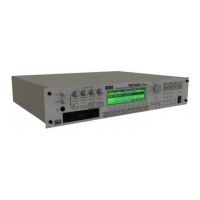34
1.1–3: Mix (Mixer)
Here you can set the pan and volume for each timbre 1–8.
1.1–3a: Pan, Volume
Pan [RND, L001...C064...R127]
Sets the pan for each timbre 1–8. (This parameter can also be
set from the Mixer page of 2.1: Ed-Prog/Mix.)
L001...C064...R127: A setting of L001 is far left and R127 is
far right. A setting of C064 will reproduce the pan setting
that was made for the oscillator in Program mode.
If a mono-type insertion effect is inserted, the setting you
make here will be ignored. In this case, the “Pan (CC#8)”
parameter in 7.2: Ed–InsertFX, Setup page will adjust the
panning of the sound after the insertion effect (☞p.145 “3.
Mixer”).
RND: The oscillator pan will change randomly at each note-
on.
If “Status” (3.1–1a) has been set to INT, MIDI control
change #10 (panpot) messages can be received to con-
trol the setting. CC#10 values of 0 or 1 will place the
sound at far left, 64 at center, and 127 at far right.
Pan can be controlled by messages received on the
“MIDI Channel” (3.1–1a).
Volume [000...127]
Adjusts the volume of each timbre 1–8. (This parameter can
also be set from the Mixer page of 2.1: Ed-Prog/Mix.)
The volume of each timbre is determined by multiply-
ing this volume value with the MIDI volume (CC#7)
and expression (CC#11). If “Status” (3.1–1a) has been
set to INT, incoming MIDI CC#7 or CC#11 messages
will control the volume of a timbre. (However these
messages will not affect the setting of this parameter.)
If “Status” is EXT or EX2, the value of this parameter
will be transmitted as MIDI CC#7 when the combina-
tion is changed. However this will not be transmitted
by a timbre that is set to the same MIDI channel as the
global MIDI channel. This message is transmitted on
the “MIDI Channel” (3.1–1a) specified for each timbre.
■ 1.1–3b: UTILITY
☞ “Write Combination,” “Solo Selected Timbre,” “Select by
Category” (1.1–1d)
For details on how to select the desired utility function, refer
to “PROG 1.1–1d: UTILITY.”
Hold Balance
Adjusts the volume of the Combi while preserving the vol-
ume balance between timbres 1–8.
Selects the “Volume” of any timbre, select “Hold Balance”
from the Utility menu, and press the [F8] (“OK”) key. A
check mark will appear at the left of “Hold Balance.” (The
upper left of the LCD screen will indicate [Hold Bal.]) In this
state, adjusting any “Volume” value will simultaneously
change the volume of the other timbres as well, while pre-
serving the volume balance between timbres 1–8.
1.1–4: Arp. A (Arpeggio Play A)
1.1–5: Arp. B (Arpeggio Play B)
Here you can make arpeggiator settings for the combina-
tion. A combination can run two arpeggiators simulta-
neously. Arpeggiator parameters can be edited in 6.1: Edit-
Arp., but certain major parameters can be edited in these
pages as well. You can edit these parameters in realtime, for
example by changing the arpeggio pattern while playing in
COMBI 1.1: Play.
To save the edits you make, use “Write Combination.” The
arpeggiator can also be edited in realtime by the REALTIME
CONTROLS C-mode [TEMPO] knob, [ARP-GATE] knob,
and [ARP-VELOCITY] knob.
1.1–4(5)a: Arpeggiator Run, Timbre assign
Arpeggiator Run A, B (Run A, B) [Off, On]
When the [ARP ON/OFF] key is on, the arpeggiator that is
checked here will run if it is assigned to a timbre in “Assign”
(6.1–1b).
Even if the arpeggiator is on, you can turn A and B on/off
independently.
(This parameter can also be set from the 6.1: Ed-Arp. Setup
page.)
Timbre assign
This displays the timbres 1–8 to which arpeggiators A and B
are assigned. This can be set in “Assign” (6.1–1b).
1.1–3a
1.1–3b
OSC1: Amp1 Pan=L001
OSC2: Amp2 Pan=R127
Left
Center
Right
Pan (CC#10)
C064
Left
Center
Right
L032
L001
R096
R127
Left
Center
Right
Left
Center
Right
OSC1
OSC2
OSC1: Amp1 Pan=L032
OSC2: Amp2 Pan=R096
Pan (CC#10)
C064
L032
L001
R096
R127
OSC1: Amp1 Pan=C064
OSC2: Amp2 Pan=C064
Left
Center
Right
Pan (CC#10)
C064
Left
Center
Right
L032
L001
R096
R127
OSC1
OSC2
1.1–4a
1.1–4b
1.1–4c

